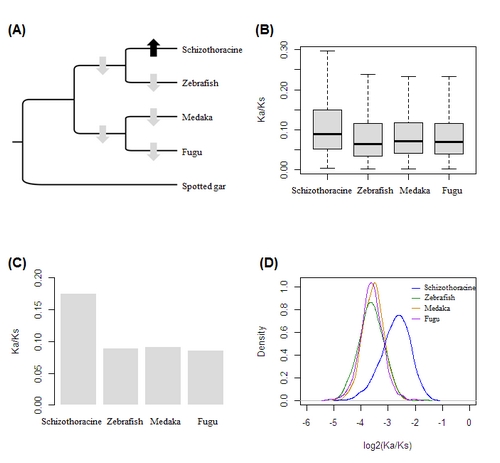
Newsroom
Schizothoracine Fishes Show Accelerated Genic Evolution in Adaptation to Tibetan Plateau
The Tibetan Plateau is the highest and largest plateau on earth, with an area of 2.3 million km2 and an average elevation of 4,500 m above sea level. Because of the high altitude, the Tibetan Plateau imposes many inhospitable living conditions on endemic species, including a low partial pressure of oxygen and high ultraviolet radiation. Recent studies on endothermic vertebrates have provided some insights into the molecular basis of adaptation to the Tibetan Plateau. However, little is known about the genomic bases of adaptation to highland in fishes.
The research group led by Prof. HE Shunping at Institute of Hydrobiology (IHB), Chinese Academy of Sciences performed transcriptome sequencing and comprehensive evolutionary analysis of a Tibet fish (Gymnodiptychus pachycheilus). Their study aims to reveal the genic bases of how schizothoracine fishes adapt to the Tibetan Plateau.
In their study, a total of 22 million high-quality 101-bp paired-end reads were sequenced and 66,105 unigenes were assembled. Comparative gene annotations from other species revealed that at least 350 genes lost and 41 genes gained since the divergence between G. pachycheilus (a high altitude fish) and zebrafish (a low altitude fish). Comprehensive evolutionary analysis indicated that G. pachycheilus showed accelerated evolution at a whole genomic scale compared with other fishes. Only the terminal branch of G. pachycheilus had an elevated Ka/Ks ratio (the ratio of non-synonymous to synonymous substitutions rate) than the putative ancestor.
Many functional categories associated with energy metabolism and hypoxia exhibited rapid evolution in G. pachycheilus relative to zebrafish. Genes showing signature of rapid evolution and positive selection in the G. pachycheilus lineage were also enriched in functions associated with energy metabolism and hypoxia.
This study provided the first investigation of the genic mechanism of adaptation to the Tibetan Plateau in fishes at a genomic scale. The results were published in Genome Biology and Evolution with the title “Comprehensive transcriptome analysis reveals accelerated genic evolution in a Tibet fish, Gymnodiptychus pachycheilus”.
This work was supported by the Pilot Projects and the Major Research Plan of the National Natural Science Foundation of China.
Keywords: Tibetan Plateau, Adaptation, Positive selection, Schizothoracine fish, Transcriptome
 |
|
Figure: Accelerated evolution on the lineage leading to Tibet fish. (Figure by YANG Liandong) |